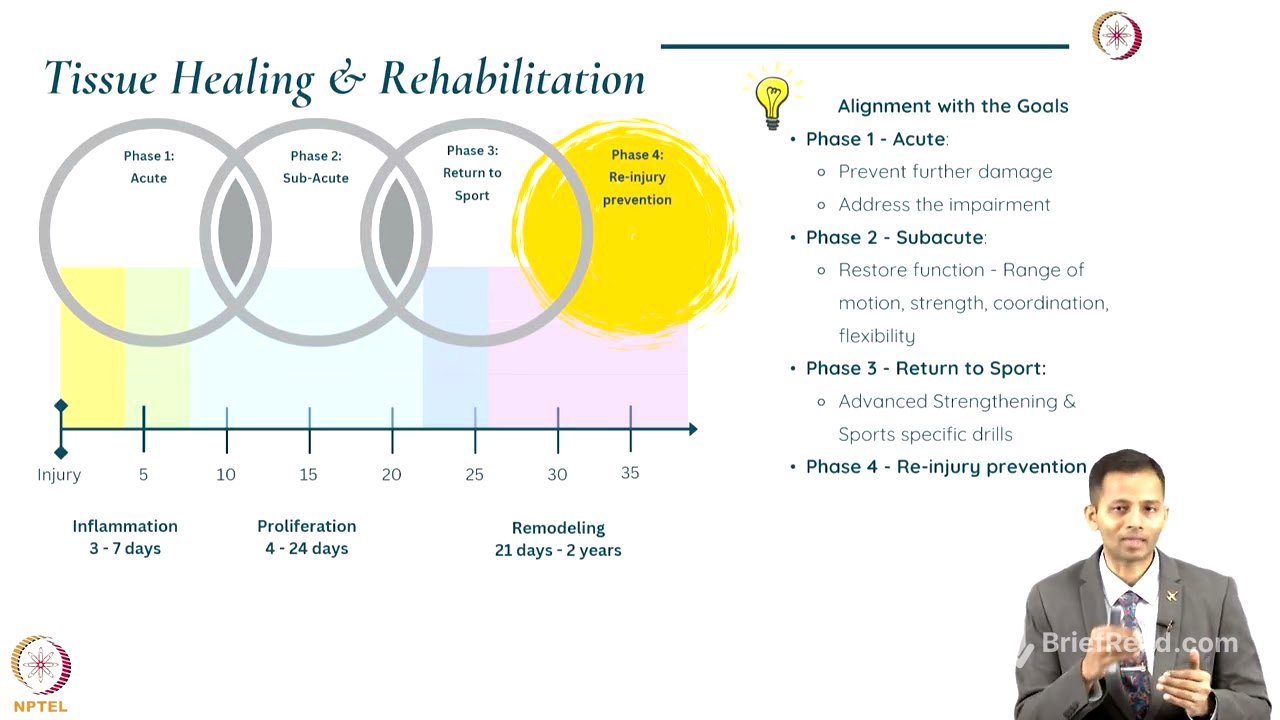TLDR;
This lecture provides an overview of sports rehabilitation, focusing on the principles, aims, and phases involved in returning an injured athlete to their sport safely and effectively. It highlights the importance of understanding tissue healing, addressing impairments, and preventing re-injury through structured rehabilitation programs.
- Aims to return athletes to sports safely and timely.
- Focuses on tissue healing principles and rehabilitation phases.
- Emphasises injury prevention and athlete-centred care.
Introduction [0:15]
The lecture begins by illustrating a scenario where a young football player sustains a muscle pull, emphasising the need for coaches and therapists to determine when an athlete is fit to return to training without risking re-injury. The speaker, Wing Commander Dr. Chandra Shakha Guru, outlines the lecture's objectives, including understanding rehabilitation principles, defining aims and goals, understanding tissue healing, and discussing sport-specific aspects during different rehabilitation phases.
Aims and Goals of Rehabilitation [1:49]
The primary aim of sports rehabilitation is to safely and promptly return the injured athlete to their sport. This involves several goals: immediately arresting further tissue damage and addressing impairments, restoring strength and function to pre-injury levels, and preventing or minimising the risk of re-injury upon returning to sports. Achieving these goals requires understanding the body's physiological response to injury and the principles of tissue healing.
Principles of Tissue Healing [2:52]
The body's response to injury is divided into three phases: inflammation, proliferation, and remodelling. The inflammation phase, lasting roughly 3-7 days, involves increased blood flow and the secretion of chemicals to initiate repair, marked by five cardinal signs: redness (ruber), swelling (tumor), increased temperature (caler), pain (dollar), and loss of function (functional esa). The proliferation phase involves cells laying down collagen layers to close the injury gap, with the duration depending on the injury's extent. The remodelling phase, starting after three weeks and potentially lasting years (especially in bone injuries), involves realigning collagen fibres to maintain force production.
Correlation with Sports Rehabilitation [6:26]
Sports rehabilitation aligns with the three phases of tissue healing, adding a fourth phase for injury prevention. Phase one (acute phase) focuses on preventing further damage and addressing impairments. Phase two (proliferation phase) aims to restore function, including range of motion, strength, coordination, and flexibility. Phase three (remodelling phase) involves advanced strengthening and sport-specific drills to return the athlete to their pre-injury level. Phase four focuses on long-term injury prevention to reduce the risk of re-injury.
Specific Targets in Each Phase [8:36]
In phase one (acute phase), the primary targets are controlling inflammation, managing pain, and increasing range of motion through passive and active exercises. Addressing motor control by activating sensory receptors and improving joint stability is also crucial. Phase two focuses on maintaining pain control, progressing range of motion, and emphasising motor control through balance, proprioception, and stability exercises. Restoring activities of daily living is essential for boosting confidence. Phase three involves sport-specific drills, advanced strengthening, and reducing pain to facilitate further strengthening. Phase four aims to achieve full range of motion without pain, improve technique, and incorporate corrective measures into the athlete's daily training to prevent re-injury.
Detailed Look at Each Phase [16:36]
Phase one focuses on arresting damage using the "POLICE" protocol (Protection, Optimum Loading, Ice, Compression, Elevation). Optimum loading is favoured over complete rest to promote faster recovery. Muscle activation and mobility exercises are introduced to restore basic movement. Phase two emphasises motor control, balance, and proprioception, with the goal of restoring function in activities of daily living. Proprioceptive exercises, such as single-leg stands, are incorporated. Phase three involves returning to sport by improving advanced strengthening activities and sport-specific drills. Objective functional tests, like single-leg hop tests, are used to assess fitness levels. Phase four focuses on preventing re-injury by addressing risk factors, correcting techniques, and incorporating balance and proprioception exercises into the daily training cycle.
Practical Aspects of Implementation [25:32]
Successful sports rehabilitation is athlete-oriented, involving informed decision-making in consultation with the athlete. The rehabilitation program depends on the athlete's level, with professional athletes often following accelerated protocols. Collaboration with the coach and trainer is crucial for fixing timelines and designing progression. Nutrition, psychological support, and adherence are vital components. Technology, such as reminder notifications, can increase adherence. The process involves preventing further damage, modifying activity, focusing on pain modulation and range of motion, restoring function in daily activities, and incorporating long-term injury prevention models.
Summary [29:46]
Rehabilitation must align with the principles of inflammation and tissue healing. Sports rehabilitation uniquely focuses on movement patterns from phase one, with technique and mechanical corrections helping to reduce re-injury chances. Addressing impairments and limitations is crucial to avoid re-injury. An objectively structured and realistic rehabilitation program yields better outcomes, and incorporating a long-term injury prevention program in sports training is always important.








